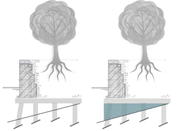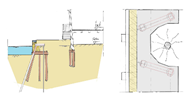Researcher: Andrea Vargas Farias
Project Duration: 01 September 2022 – 31 August 2026
Project Partner: TU Delft, Eindhoven University, Saxion University of Applied Science, Municipality of Amsterdam, Muncipality of Den Haag, Muncipality of Zwolle, Tauw, Boskalis, deBeaufort bouwadvies, H.D.Sneep Holding, VVAB, CROW
Project Description:
Historic quay walls and bridges are a landmark in many Dutch cities and give them their unique character and appearance. The cultural value of these structures is at stake. Accelerated deterioration, deferred maintenance, and changed social, technological, and environmental conditions have drastically decreased their technical and functional performance. Maintaining the cultural heritage of inner-city quay walls and bridges and at the same time preparing them for the future is a huge challenge for many Dutch municipalities. Lifespan-extension is a promising way to cope with this challenge. It can increase the structural reliability of quay walls and bridges in a sustainable and circular manner while preserving the cultural value. However, less is known on the structural, environmental, economic, and cultural impact of lifespan-extension measures and their assessment for the management of quay walls and bridges.
Based on engaged research with municipalities, contractors, engineering firms and citizens STABILITY addresses this knowledge gap. It combines the development of an integrated life cycle cost benefit approach for the sustainable and circular impact assessment of lifespan-extension measures, with the development of an assessment method for the structural reliability improvement of these measures and the development of an adaptable planning method to optimally prioritize and schedule lifespan-extension measures. STABILITY equips municipalities with the required decision-support to devise rehabilitation strategies for historic inner-city quay walls and bridges that reduce construction waste and emissions, preserve the cultural heritage of cities, and keep cities accessible, attractive, and livable.



